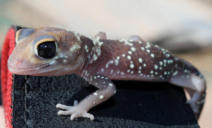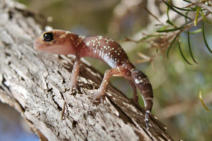

Barking gheko



Underwoodisaurus milii is a
species of Gekkonidae also
classified as Nephrurus milii. It
is commonly known as the thick-
tailed or barking gecko. These
names come from its distinctive
plump tail and sharp, barking
defensive call.
Thick-tailed geckos are reddish-
brown with bands of white and
yellow spots and paler
underbelly. They usually grow to
120–140 mm in length.[1] Their
original tail is black with
several pale bands, however
regenerated tails have little pattern.
When threatened, they will arch their backs and "bark".
Thick-tailed geckos are found in rocky outcrops across
southern Australia, and are slightly more cold-tolerant
than many other Australian gecko species. They are
nocturnal, and shelter underneath rocks or in burrows
during the day. They feed on insects and small
vertebrates.Unusually for reptiles, this species forms
aggregations in their retreat sites during the day. The
reasons for this are unknown. However, it has been shown
that this behavior results in a higher aggregate thermal
inertia (they stay warmer) than would be found in solitary
geckos of this and related kinds in similar circumstances
In the same source, it was suggested that aggregating for
physiological benefits may precede the development of
other kinds of social behavior. This species, and some
other species of gecko have the unusual habit of licking
their eyes after eating, presumeably to keep the eyeshield
moist and clean.





Barking gheko



Underwoodisaurus milii is a species of
Gekkonidae also classified as Nephrurus milii.
It is commonly known as the thick-tailed or
barking gecko. These names come from its
distinctive plump tail and sharp, barking
defensive call.
Thick-tailed geckos are reddish-brown with
bands of white and yellow spots and paler
underbelly. They usually grow to 120–140 mm
in length.[1] Their original tail is black with
several pale bands, however regenerated tails
have little pattern.
When threatened, they will arch their backs
and "bark".
Thick-tailed geckos are found in rocky
outcrops across southern Australia, and are
slightly more cold-tolerant than many other
Australian gecko species. They are nocturnal,
and shelter underneath rocks or in burrows
during the day. They feed on insects and small
vertebrates.Unusually for reptiles, this species
forms aggregations in their retreat sites
during the day. The reasons for this are
unknown. However, it has been shown that
this behavior results in a higher aggregate
thermal inertia (they stay warmer) than would
be found in solitary geckos of this and related
kinds in similar circumstances In the same
source, it was suggested that aggregating for
physiological benefits may precede the
development of other kinds of social behavior.
This species, and some other species of gecko
have the unusual habit of licking their eyes
after eating, presumeably to keep the eyeshield
moist and clean.














































































